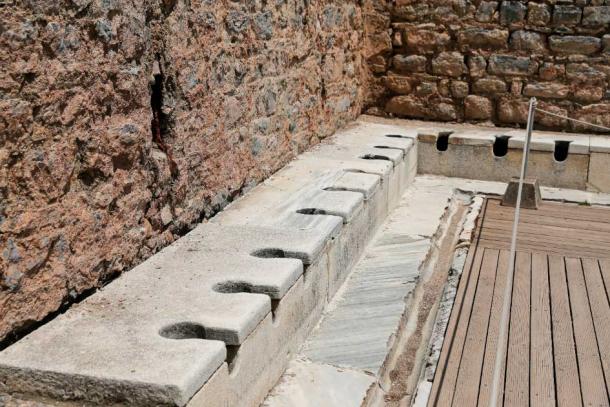Archaeologists have unearthed the bottom half of a manual flush toilet that dates back 2,400 years in the Yueyang archaeological site in China’s Shaanxi province. Yueyang served as a capital city under multiple ancient Chinese dynasties. It will likely reveal a lot about the eating habits of ancient people by analyzing soil samples taken from the toilet bowl.
This was not just the layman’s toilet, but rather, believed to have been used by high-ranking members of society, such as Qin Xiaogong (381-338 BC) or his father Qin Xian’gong (424-362 BC), during the Warring States Period (475-221 BC), or by Liu Bang (206 BC-AD 220), the first emperor of the Han Dynasty! The upper half of the toilet has not been found, so researchers are not sure if its users squatted or sat.
A Technologically Advanced Society, A Sophisticated Design
“It is the first and only flush toilet to be ever unearthed in China,” archaeologist Liu Rui told China Daily . “Everybody at the site was surprised, and then we all burst into laughter… The toilet provides concrete evidence of the importance ancient Chinese people attached to sanitation,” explained Rui, who is also a researcher at the Institute of Archaeology at the Chinese Academy of Social Sciences.
This discovery provides insight into the level of technological advancement achieved by the Qin Kingdom and the Han Dynasty. The ability to construct and use a flush toilet required knowledge of water supply, waste management, and hygiene practices , which were not widespread during that time. This discovery also sheds light on the daily lives of the elite members of society who lived in the palace complex and had access to such advanced facilities.
The toilet’s design, which included a pipe that emptied into an outdoor pit, highlights the importance of sanitation in ancient China. Indoor toilets were uncommon during that period, and the use of such technology was likely limited to a small segment of the population. The excavation of the toilet has provided concrete evidence of the efforts made to maintain cleanliness and hygiene in ancient Chinese society.
In addition to the physical remains of the toilet, archaeologists are also analyzing soil samples taken from the excavation site. The soil samples could reveal information about the diet and health of the people who used the toilet, in addition to other relevant details.
The analysis of the samples could provide insights into the agricultural practices and fertilizer use, for example, during the Han Dynasty, reports The Global Times . They also make excellent reference points for the urban planning of respective historical states. “Besides all written records, we can learn more about social reforms and systems of the kingdom by digging deeper into ancient palaces,” added Liu.
Flush Toilet: A Clogged History?
The discovery of the flush toilet in China is significant, as it predates the commonly accepted history of flush toilets, which are believed to have been invented in the late 16th century. The invention of the flush toilet is generally attributed to John Harington, who designed one for Queen Elizabeth I.
However, the discovery in China shows that the concept of a flush toilet was not entirely unknown in other parts of the world, and the technology may have been independently developed in different regions. The earliest evidence, in fact, comes from the Indus Valley Civilization , from around 2500 BC! Simple toilets would be emptied out through a sump, which would sift the sewage into street drains.
The ancient Greeks and Romans also had rudimentary flushing toilets, but these were only available to the wealthy and were often connected to public sewage systems. During the Middle Ages in Europe, toilets were often built above rivers, which helped to wash away waste. However, as cities grew, the problem of waste disposal became more difficult to manage, and people began to rely on chamber pots, which were emptied into the streets or rivers.

Ancient Roman communal toilets. Source: EvrenKalinbacak / Adobe Stock
The first ‘modern’ flush toilet was invented by Sir John Harrington, a godson of Queen Elizabeth I of England, in 1596. His design used water from a cistern to flush waste down a pipe into a cesspit. Although Harrington’s design was innovative, it was not widely adopted at the time.
It wasn’t until the mid-19th century that the modern flush toilet became widely used. In 1851, an English plumber named George Jennings invented a public flush toilet that was installed in the Crystal Palace, a large exhibition hall in London. His design featured a valve that could be flushed by pulling a chain. The design was a huge success and soon spread throughout the world.
Top image: Broken parts of the flush toilet unearthed from the Yueyang archaeological site in Xi’an, Shaanxi province. Source: China Daily .
By Sahir Pandey
Related posts:
Views: 0
 RSS Feed
RSS Feed

















 February 19th, 2023
February 19th, 2023  Awake Goy
Awake Goy  Posted in
Posted in  Tags:
Tags: 
















